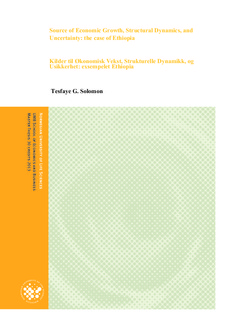Sources of economic growth, structural dynamics, and uncertainty : the case of Ethiopia
Master thesis
Permanent lenke
http://hdl.handle.net/11250/187484Utgivelsesdato
2013-10-01Metadata
Vis full innførselSamlinger
- Master's theses (HH) [1072]
Sammendrag
The performance of the Ethiopian economy has been poor for a long time before the recent high
growth since 2004. This therefore triggers a question what the reasons could be behind the poor
economic performance, and what have been the changes that have taken place. This study
covered three periods, covering 1960-2010, over which time there have been different economic
systems namely: a mixed economy from 1960-1972; a socialist economy from 1973 to 1991; and
a transition economy from 1992This study develops a model to explain the effect of factor inputs
determining economic growth, evaluate the overall technological progress, and assess the
contribution of structural dynamics and rainfall. A translog production function was applied to
develop the mode. The results indicated that physical capital contributed positively (P=0.012) to
economic growth whereas labor was not statistically significant (P>0.1). It was also found out
that the change in production structure of the economy has been contributing positively to
growth (P= 0.041). The results of two rainfall variables have the expected signs, and the effect
of the “main rain” season was negative. The findings of this study also revealed that the growth
of total factor productivity (TFP), in its broad sense, and the rate of technical change were not
boosting growth. The implication is that an emphasis should be given to physical capital
accumulation, promoting structural transformation of the economy, while reengineering
technical and technological factors so that performance of the economy is driven by productivity
growth, and the need to address the negative effect of the “main rain” season.
Key words: Economic growth, Factor accumulation, TFP, Structural change, Rainfall
